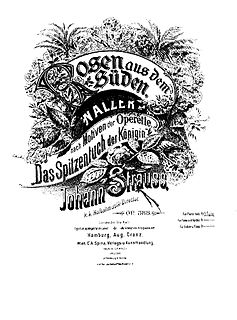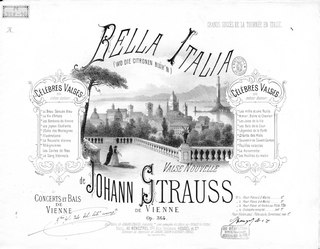This article needs attention from an expert in Austria. The specific problem is: This Austria-related article went unedited for about five years. That cannot stand. Needs expansion, verification, and neutralization.(August 2018) |
Nachtfalter (Moths) op. 157 is a waltz by Johann Strauss II written in 1854. The waltz was first performed at a parish festival ball at Unger's Casino in the suburb of Hernals, Vienna on 28 August of the same year.

The waltz is a ballroom and folk dance, normally in

Johann Strauss II, also known as Johann Strauss Jr., the Younger, the Son, son of Johann Strauss I, was an Austrian composer of light music, particularly dance music and operettas. He composed over 500 waltzes, polkas, quadrilles, and other types of dance music, as well as several operettas and a ballet. In his lifetime, he was known as "The Waltz King", and was largely responsible for the popularity of the waltz in Vienna during the 19th century.

Hernals is the 17th district of Vienna, Austria . Hernals is in northwest Vienna. It was annexed in 1892 out of the townships of Hernals, Dornbach, and Neuwaldegg.
The work, which first suggests the whirring of the wings of a moth in the Introduction and then its circling flight, failed to gain the recognition many now feel it deserves when first performed in 1854. The Danube monarchy has formed an alliance with France and Great Britain during the Crimean War and the action has incurred the wrath of the Russian Tsar. Vienna at that time was also recovering from a devastating cholera outbreak that autumn and many entertainment establishments were finding it difficult to attract patronage to their dance halls and Strauss' works during that time do not reach a wider public attention.

Moths are a polyphyletic group of insects that includes all members of the order Lepidoptera that are not butterflies, with moths making up the vast majority of the order. There are thought to be approximately 160,000 species of moth, many of which have yet to be described. Most species of moth are nocturnal, but there are also crepuscular and diurnal species.

France, officially the French Republic, is a country whose territory consists of metropolitan France in Western Europe and several overseas regions and territories. The metropolitan area of France extends from the Mediterranean Sea to the English Channel and the North Sea, and from the Rhine to the Atlantic Ocean. It is bordered by Belgium, Luxembourg and Germany to the northeast, Switzerland and Italy to the east, and Andorra and Spain to the south. The overseas territories include French Guiana in South America and several islands in the Atlantic, Pacific and Indian oceans. The country's 18 integral regions span a combined area of 643,801 square kilometres (248,573 sq mi) and a total population of 67.02 million. France is a unitary semi-presidential republic with its capital in Paris, the country's largest city and main cultural and commercial centre. Other major urban areas include Lyon, Marseille, Toulouse, Bordeaux, Lille and Nice.

The Crimean War was a military conflict fought from October 1853 to February 1856 in which the Russian Empire lost to an alliance of the Ottoman Empire, France, Britain and Sardinia. The immediate cause involved the rights of Christian minorities in the Holy Land, which was a part of the Ottoman Empire. The French promoted the rights of Roman Catholics, while Russia promoted those of the Eastern Orthodox Church. The longer-term causes involved the decline of the Ottoman Empire and the unwillingness of Britain and France to allow Russia to gain territory and power at Ottoman expense. It has widely been noted that the causes, in one case involving an argument over a key, have never revealed a "greater confusion of purpose", yet they led to a war noted for its "notoriously incompetent international butchery".
Strauss' work eventually enticed Liszt, who was made aware of the work's charms. The latter was observed at a festive occasion to earnestly entreating his daughter Cosima Wagner to play 'Nachtfalter' with his as a piano duet. Further, performances abroad such as in Pavlovsk and the later in Paris, confirmed the work as one of Strauss' earlier inspired creations.

Cosima Wagner was the illegitimate daughter of the Hungarian pianist and composer Franz Liszt and Marie d'Agoult. She became the second wife of the German composer Richard Wagner, and with him founded the Bayreuth Festival as a showcase for his stage works; after his death she devoted the rest of her life to the promotion of his music and philosophy. Commentators have recognised Cosima as the principal inspiration for Wagner's later works, particularly Parsifal.

The piano is an acoustic, stringed musical instrument invented in Italy by Bartolomeo Cristofori around the year 1700, in which the strings are struck by hammers. It is played using a keyboard, which is a row of keys that the performer presses down or strikes with the fingers and thumbs of both hands to cause the hammers to strike the strings.

Pavlovsk is a municipal town in Pushkinsky District in the suburban part of the federal city of St. Petersburg, Russia, located 30 kilometers (19 mi) south from St. Petersburg proper and about 4 kilometers (2.5 mi) southeast from Pushkin. Population: 16,087 (2010 Census). Known since late 18 century, when Saint Petersburg was the capital of Russian Empire, as a countryside residence of Russian royal family commissioned creation of the town's landmark -palace with a large park, now parts of its federal museum reserve.






